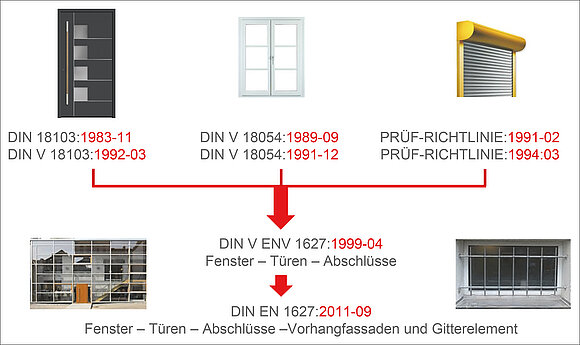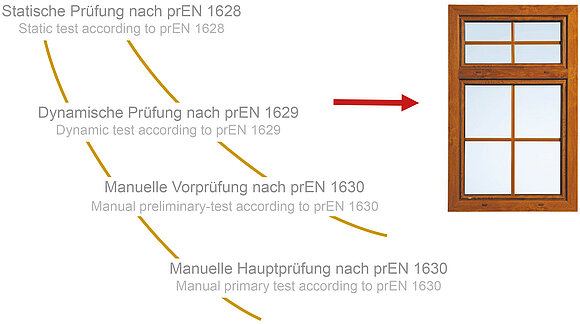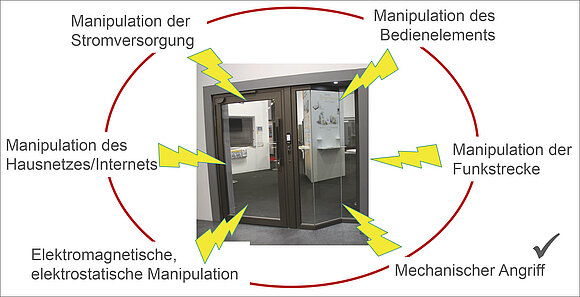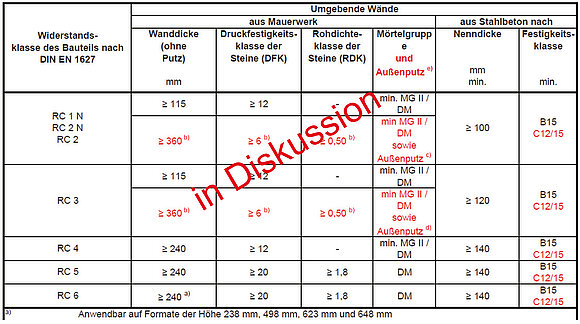Reading time: 1 minute
The standardisation of burglar-resistant windows, doors and roller shutters has a long tradition in Germany and also in Europe.

On the basis of an ift test guideline for burglar-resistant windows, a basis for the evaluation of burglar-resistant doors was already established in 1983 with DIN 18103 and in 1989 with DIN V 18054 a prestandard for burglar-resistant windows was established. Furthermore, a test guideline for the testing of burglar-resistant roller shutters existed since 1991. Both DIN standards as well as the test guideline of the Federal Association of Roller Shutters and Sun Protection then formed the basis for DIN V ENV 1627 et seqq., published in 1999 and known on the market. After 12 years of prestandard period, the prestandard could then become a “real” EN standard in 2011. Now the most important standards series for burglary protection is due to be further developed and revised on a regular basis.
Draft Standards prEN 1627 et seqq.
Possible changes in the new draft standards of prEN 1627 et seqq., which are expected to be published in the first half of 2019, are presented below. This information reflects the current status of standardisation work and the discussion in Working Group 7 (WG7). There will be no changes to the basic test procedure of a burglary test according to prEN 1627et seqq. Also in the future, the proven 3-stage test sequence with static test, dynamic test and manual preliminary and main test will be retained. All three partial tests must pass the defined requirements in order to be “newly” classified according to prEN 1627.

Expected changes in prEN 1628 (static test):
For the static test, only a few essentially editorial changes are to be expected. New will be a gap gauge "Type C" with the shape of an ellipse of 250 mm x 150 mm and a thickness of 20 mm. This gap gauge replaces the gap gauge 3 used up to now. In future, the new gap gauge will only be provided for burglar-resistant components of "Product Group 4" (such as grilles).
Expected changes in prEN 1629 (dynamic test):
Also for the dynamic test, only a few editorial changes are to be expected. With the dual tyre impactor test method, everything remains the same – even the test is only carried out on components in the resistance classes RC1N to RC 3.
Expected changes in prEN 1630 (manual test):
An additional template E4 is expected for the evaluation of “accessible opening”. The rectangular evaluation template with the dimensions 150 mm x 660 mm (width x height) should only be used for fixed-glazed side panels and top lights. New will be an additional Annex E, which allows the testing of the “extraction protection” for profile cylinders, if no proof of a testing body is available. Most important, however, is the fact that the composition of tool sets A1 to A6 will remain almost unchanged.
Expected changes in prEN 1627 (specification and classification):
For prEN 1627, significant extensions, additions and innovations are planned. This is immediately apparent from the scope of the standard: The current version of DIN EN 1627:2011 contains 44 pages (including the national annex), whereas the future version prEN 1627 will have approx. 63 pages.
One of the important changes is the integration of windows and doors equipped with mechatronic building hardware products. Therefore, a new Annex E, “Mechatronic and electronic security systems” was prepared. This describes additional requirements for building hardware defined in Tables 2A and 2B. The application of the standard will show in which form the defined requirements in Annex E as well as any test scenarios required can be reproducibly implemented within the scope of manual burglary testing. Overall, the discussion in WG 7 has shown that there is little experience in testing burglar-resistant components in conjunction with mechatronic building hardware products.

Furthermore, Section 6 “Hardware” in EN 1627 has been completely revised. The new table “2A – Key related security" describes requirements and defines classes of building hardware such as profile cylinders according to EN 1303 or lockable window handles according to EN 1316-3 for the “Security of the locking system” or its keys. The new table “2B – Attack related security" defines requirements and defined classes of building hardware with regard to mechanical attack resistance. For example, security furniture on a burglar-resistant door must comply with resistance class RC 2 of class 3 according to EN 1906. If this is not the case, the suitability can be demonstrated by means of a new, alternative means of proof by manual testing. This possibility can also be realised for other building hardware such as profile cylinders or locks. Due to these new requirements in Tables 2C to 2H, the previously known Annex B has been completely eliminated.
Expected changes in National Foreword (NA) to prEN 1627 (specifications and classification):
It is to be expected that the tables will be expanded to include requirements for masonry. Basis for the verification of the installation of burglar-resistant components in brickwork with materials of a resistance class lower than 12 N/mm² are results of a research project at ift Rosenheim, which prove that the installation of burglar-resistant components in the resistance classes RC 1N to RC3 in brickwork with a compressive strength class of 6 N/mm² is possible.

Summary and Perspective
The revised drafts of prEN 1627 et seqq. are expected in the first half of 2019. From today's point of view, these are the main changes and innovations:
- Integration of mechatronic hardware and building components,
- Changes in the requirements for hardware for windows and doors
- Alternative verification possibilities for the evaluation of hardware in burglar-resistant components
The extent to which the innovations in the draft standards will be accepted in the European voting procedure cannot currently be estimated. However, it is clear that it will be difficult to find a consensus within Europe.


